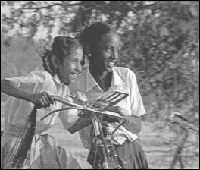|
|
|
監督:シャブナム・ヴィルマニ
Director : Shabnam Virmani |
日刊紙タイムズ・オブ・インディアの記者としてジャイプールで働き、ラジャスターンの農村でのサティ(寡婦の殉死:夫の死体と共に妻が生きながら焼かれる風習)についてリポートするなかで、それ以後続く女性の権利拡張問題への関心を持ちはじめる。アメリカのコーネル大学で発達コミュニケーション学の修士過程を終えてインドに戻り、それ以来、自国の女性運動との緊密な共同作業の中で映画を撮り続けている。アーメダバードにて、女性の権利や人権問題を扱ったビデオ製作と演劇活動のプロ集団、ドリシュティ・メディアグループを創始し、現在に至る。 Worked with the Times of India daily in Jaipur as a journalist. Reporting on a Sati (widow self-immolation) in rural Rajasthan triggered off an abiding interest in women's development issues. Did a Master's in Development Communication from Cornell University, USA, returned to India and has been making films ever since in close collaboration with the women's movement in her country. Initiated and works with the Drishti Media Collective in Ahmedabad, a group of video and theatre professionals working on women's and human rights concerns. |
 |
|
| 三人の女性ソーシャルワーカーが、簡潔な言葉でしかも紅潮した顔で語るこの映画は、インドのマダヤ・プラデッシュに巣喰う複雑な差別のメカニズムに正面から立ち向かい、そのために失ったものや巻き込まれた悲劇にも打ち克ちながら自らを強くし、またその助けを必要とする女性を力づけている彼女たちの物語だ。映画のなかで流れている主題曲は、未来へと道を切り拓く活動家たちの輝くような精神と勇気を称えている。 | CurrentsSimple words and glowing faces depict the story of three women social workers who triumph over personal loss and tragedy to empower themselves and other women in need, in the face of complex discriminatory mechanisms in Madhya Pradesh in India. A recurring theme song highlights the spirit and courage of the activists who pave new paths for the future. |
|
|
|
|
監督のことば 私の作品は非常に根本的なところで、母国であるインドの女性運動に動機づけられています。私はビデオを、女性の経験を表現するメディアとして主に用いてきました。異なる文化に暮す女性が私の作品を見て議論するのを見たり、それが彼女たちの生活や自己認識、そして世界観にある差異を生じさせているのを感じたりすることが、私が作品を作ったことによって得られる最大の満足なのです。 私は女性に「ついて」ではなく女性と「共に」映画を作っていることを強調したいと思います。この方法論は、女性たちの闘争を支援し、かつ高めるために意識的に必要とされ、産み出されたものです。映画製作の過程においては、女性を受動的な「客体」に引き戻すべきではなく、女性を能動的な「主体」としてそこに巻き込むべきなのです。しかもこの過程は、作品の完成するための単なる手段ではなく、作り手と参加した女性たちがお互いに自身を高めあうような経験であるべきです。私は自分のテーマである「女性」を、事前調査や脚本、演技など映画作りの過程に巻き込むような作り方を楽しんでいます。その意味では、私の映画には強烈な「個人的」表現よりも、社会的な現実の「集団的」表現のほうがずっと多いのです。 |
Director's Statement My work has been motivated in a very fundamental way by the women's movement in my country, India. I have primarily used video as a via media for expression of women's experiences. To see my films being watched and discussed by women of different cultures, to get a sense of it making a difference to their lives, their self-perception, their world-view, is the greatest satisfaction I derive from my work. I would like to stress that I make films " with " and not " on " women, and this methodology has emerged from a conscious need to strengthen and support women's struggles. The filmmaking process must not reduce women into passive " objects, " but involve them as active "subjects" in the film process. This process has to be a mutually enriching experience for the filmmaker and the women involved, not just be a means to an end Product. I enjoy making films that involve my subjects (women) in the research, script and acting of the filmmaking process. And in that sense, my films are much less intensely "personal" expressions, and much more " collective " expressions of social reality. |
